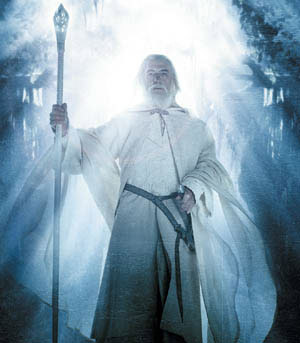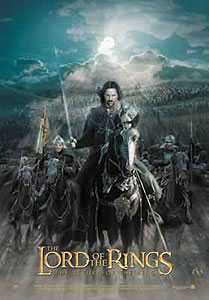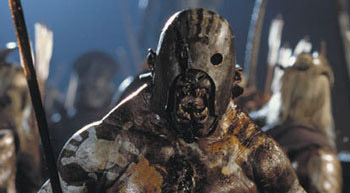
Copyrighted Material

Tolkien at the End of Time;
Alchemical Secrets of The Lord of the Rings
By Jay Weidner and Sharron Rose
Gandalf the Wizard was very likely modeled after the tales
of the Alchemical Masters of old. He plays a prominent role
in the story of the Third Age of Middle-earth. During his
confrontation with the monstrous Balrog in the depths of Moria,
he refers to himself as the 'servant of the secret fire'.
Tolkien in a letter to Robert Murray, dated 4 November 1954,
describes Gandalf as well as the other wizards as 'incarnate
angels' sent to Middle-earth in the Third Age as stewards
and emissaries to assist Elves and Men in their resistance
to the forces of darkness as the next challenge for its dominion
by the Dark Lord Sauron begins to materialize. Reminiscent
of the primary goals of the great Alchemical Masters, the
fundamental role of the Wizards as conceived by Tolkien is
to foster, nourish and strengthen this universal spirit within
humanity by educating them, advising them and keeping their
hearts and minds continuously focused upon the ' Way of the
Light'. They are, in essence, the 'Hermetic Brotherhood' of
Alchemy. Through this sacred endeavor, the courage and fortitude
to resist the enticements of the dark forces that inevitably
arise both within and without will be reinforced, and the
essential mission of the Divine Great Work, that of keeping
the vital spark of the secret fire pure and uncontaminated
will be fulfilled.
In Tolkien's tale, as in our world, even the great masters
are capable of error with its inexorable descent into darkness.
The wizards Gandalf and the powerful leader of his order Saruman,
like those that adorn the pages of the alchemical lore, are
not exempt from being tested. By weaving the story of Gandalf's
continuous struggle towards the light as demonstrated in his
self-sacrificing acts contrasted with the egregious, self-aggrandizing
acts of the fallen Sauruman, Tolkien is again bringing into
focus the unavoidable choice that befalls each and every one
of us no matter how far we rise in knowledge, power and influence.
But by sacrificing himself Gandalf not only saves Frodo, the
Ring and the Fellowship but he is turned from Gandalf the
Grey to Gandalf the White. It is this selfless act that transforms
him and gives him a greater degree of wisdom and power than
ever before. For this battle with and victory over the Balrog
through the depths of the underworld allows him to become
an even greater 'servant of the light' who can more effectively
challenge the dark, corrupted power of Sauruman. 15
Is it possible that through his research, Tolkien uncovered
the magical 'Language of the Birds', and discovered
that the fabled lore of Alchemy also appeared to resonate
through these languages? It is clear that through this knowledge
of alchemical lore, Tolkien also couldn't have helped but
notice that the weave of language appeared to be growing tighter
as these languages approached the Modern Age, that language,
like our culture, our bodies and the earth itself appears
to be densifying through time and the Four Ages of Humanity.

Tolkien's Cosmology
The Story of the Ages and the Perpetual Battle of Good
and Evil
" I believe that legends and myths are largely made
of 'truth', and indeed present aspects of it that can only
be received in this mode; and long ago certain truths and
modes of this kind were discovered and must always reappear.
There cannot be any ' story' without a fall all stories
are ultimately about the fall "
-J.R.R. Tolkien from the Preface to The
Silmarillion
In Tolkien's cosmology, which takes us from
the moment of creation to the beginnings of the Fourth Age
of Middle-earth, the essential philosophical concerns that
lie at the core of our reality are brought forward and elucidated
upon through the story line, thoughts and actions of his characters,
whether they be Elves, Wizards or Men. By being bequeathed
the gift of 'free will' by the Creator, Tolkien's characters,
like each and every one of us, is given the opportunity to
choose between good and evil, egotism and selflessness, God
and Satan- to follow the path of the light or fall into darkness
and corruption. As in the epic legends such as the Ramayana
and Mahabharata of India, the Kalivala of Finland and Norse
mythology, in every Age of the world, there is a seduction
by and fall towards darkness, with a corresponding battle
between the forces of good and evil to set the world aright
again for the people of the coming Age. The story of Tolkien's
world, like that of our own, is one of the continuous battle
of opposing forces, of light and darkness, good and evil,
beauty and horror, magic and the machine.
To gain a greater perspective on The Rings Trilogy,
one must take a look at Tolkien's history of the Ages. As
in all great creation tales, the unfolding and development
of the Ages begins with what he refers to as a cosmological
myth. As documented in The Silmarillion, from the harmonic
convergence of the Valar, (Primal Powers of the Creator) the
creative vision of the Earth appears. In the same manner as
the alchemical teachings of the Ages relates the story of
the First or Golden Age as being the Age when the gods inhabit
the earth, Tolkien's Valar, in order to fully manifest their
vision, descend from the heavens and dwell upon the Earth,
sometimes as beings of light, sometimes in material bodies.
16 At the utmost West of the world they create
their home or Paradise known as Valinor and begin to prepare
the Earth for the coming of God's Children, the Elves known
as the 'First-born' and Men, known as the 'Followers'. But
in Tolkien's ontology, as in many of the great epics, almost
immediately there is a 'fall' by the greatest of the Valars
named Melkor who later became known as Morgoth in the Elvin
tongue. He was the original dark force who, during this First
Age, perverted Sauron, one of the inhabitants of Valinor to
his service, taking him as his chief servant and representative
of evil. In his tale entitled Valaquenta from The
Silmarillion, Tolkien describes this first 'fall' of Melkor,
" From splendour he fell through arrogance
to contempt for all things save himself, a spirit wasteful
and pitiless. Understanding he turned to subtlety in perverting
to his own will all that he would use, until he became a liar
without shame. He began with the desire of the Light, but
when he could not possess it for himself alone, he descended
though fire and wrath into a great burning, down into Darkness.
And darkness he used most in his evil works upon Arda (Earth)
and filled it with fear for all living things. " (S 31)
So from the beginning of the actual formation
of the earth out of the music and vision of the Gods the corruption
of the Divine Art of Creation began. Having fallen from grace
in a manner reminiscent of the Demiurge of the Christian Gnostics,
Melkor could never create of his own accord but merely produce
counterfeit versions of pre-existing beings by twisting, distorting
and manipulating those created by the One. In this way, he
brought forth a rift into the world. For from the moment that
he 'fell' and turned his face towards egotism and tyranny,
Melkor became an irritant that could not be ignored.

With the coming of the spirit of Melkor into
the world, the great epic of Middle-earth truly begins. Tolkien's
First Age is primarily concerned with the story of the awakening,
activities and 'fall' of many of the First-born Elves and
their battles with Melkor and Sauron. This ultimately sets
the stage for the expulsion of many of the Elves from Valinor/
Paradise and their first contact with the Men of Middle-earth.
The First Age ends with the arousal of the Power of the Gods
against Melkor and Sauron (inspired by the vision of Ragnarok
from Norse mythology), the destruction of their realm and
Melkor's expulsion from the World into the Void. As in the
alchemical story of the Ages, the veils between the worlds
begin to fall, and the sight of Paradise although still visible
to the banished Elves from their Blessed Land of Eressëa
is removed from the sight of Middle-earth.
Previous
-|- Page 1 -|- Page
2 -|- Page 3 -|- Page
4 -|- Page 5 -|- Page
6 -|- Page 7 -|-Next
|



